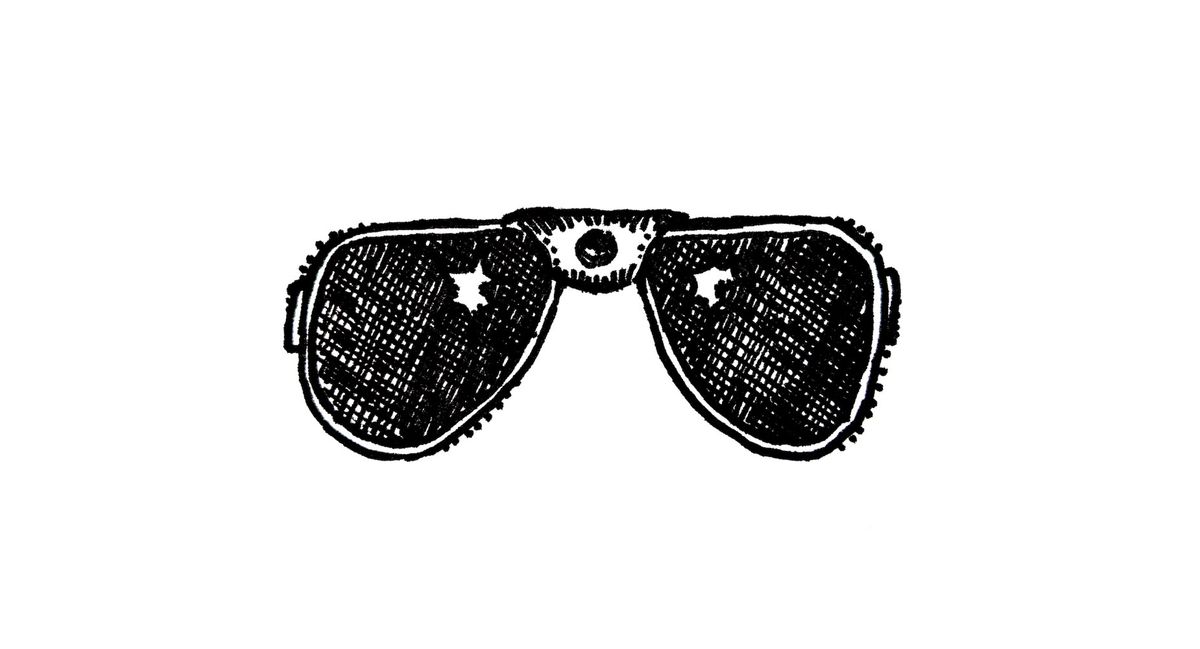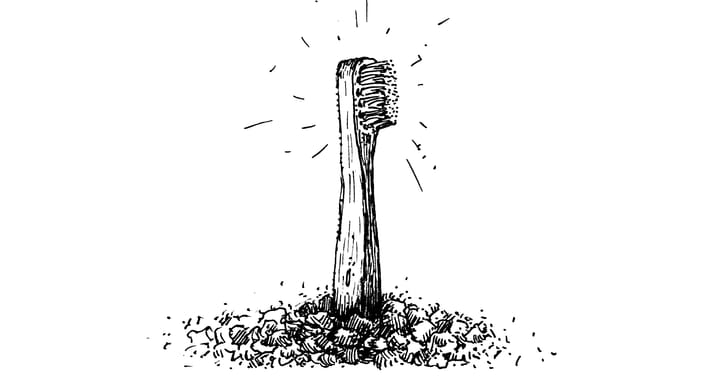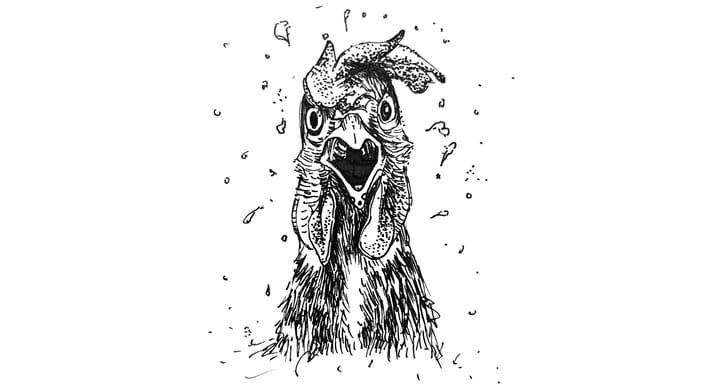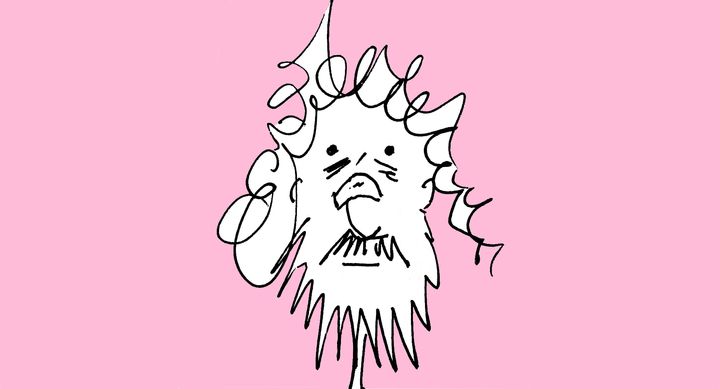Framed
Seeing isn’t always believing. A reading-glasses saga of resolution and stubbornness.

Typography at its most dastardly is being asked to make that fine judgement call between a distant E or an F, an O or a Q or a C. I didn’t always think this. Once upon a time, I would approach quoting those letters from the Snellen eye chart as competitive reading. I’ll admit a sense of satisfaction at achieving a 20/20 score, an assumption that I had won at the sport of seeing. Nice frames you sell here, Dr Optometrist, I would observe. But I don’t need any of them, because I have the eyes of an eagle.
Yet: I’ve only recently learned that 20/20 vision merely means you have decent visual acuity. And that there are other scores. The poor sod with 20/40 vision needs to be 20 feet away to see details someone with decent vision can see at 40. Then there are the rare 20/10 breeds, who can make out finer edges at 20 feet that others can only see from 10. The 20/10 people are the true eagles, and I am not one of them.
(How did I not know all of this? Well, let’s just say: I’m the kind of person who only reads the headlines.)
There’s a certain prestige attached to clarity. Consider the competitive verve with which consumers have pursued television resolution over time. It’s true that early television images left much room for improvement. Colour, for instance. But people got pretty used to what they viewed on their TVs until HD arrived on the scene, and suddenly anything that wasn’t HD was... behind the curve. The same shift would happen with 1080p, then 4K, and now even 8K. Each iteration would cast aspersions on the clarity of the previous.
Yet: There is a physical limit to what we can make out with our eyes. Is it wonderment that drives us to augment human vision beyond what we can possibly see? The qualities of a dust mote. The electrons orbiting an atom. Or are we concerned that some shoddy pixel will betray us by obscuring a critical detail? We want fidelity, in both senses. Utter precision. Faith that what we see is what is there.
There are subtler qualities for marking the standard of a person’s vision, beyond the 20/20 score: how the eyes perceive colour, contrast, depth, the periphery. And critically: the shape of the eyes – how well they can refract the light.
“You have astigmatism,” said Neela, my most-recent optometrist. “That means your eye isn’t properly round like a basketball, but more like a rugby ball.”
I’ve never played either of those sports.
I already knew my eyes were misshapen. In high school my optometrist prescribed me glasses to counter the astigmatism, but after purchasing Adidas frames my family really couldn’t afford, and wearing them in classes for a week, I started getting headaches. Perhaps the lenses were wrong, or the temples clamped too tightly around my head. I filed them away in a box, insisting I could read just fine without them.
“Have you been wearing your glasses?” Mum would ask me from time to time, hoping for a return on her investment.
“I know where they are,” I’d answer.
“Might that be why I’ve been getting the blurry eyes and the headaches – the astigmatism?” I asked Neela.
“It’s likely,” she answered.
Neela was young, perhaps a recent graduate. She had an accurate posture, the kind that makes you feel like a slouch. Was she a once a student of mine? She seemed vaguely familiar. Seeing my former high school English students as adult people in the world ages me. I feel like they’re on the up escalator and I’m on the down.
Neela’s glasses had thick black frames. It seems right that optometrists also wear glasses, so they can see where you’re coming from. There are plenty of reasons an optometrist might not have glasses (decent eyes, for one), but I feel the same way about optometrists without glasses as I do consulting with an unhealthy-looking doctor. Technicians of the body need to look the part.
“I’m giving you a prescription for glasses, which should help,” said Neela.
“So you’re saying I need glasses then?” I said. I was still trying to downplay even the idea of it, after all these years, to catch out my optometrist on a technicality.
Neela was packing up the lenses she’d used to test my eyes. She paused and wrinkled her brow.
“This is a prescription for glasses,” she said.
“Are you sure?” I said.
“You could try continuing without them. But they could really help,” said Neela.
Could, should, likely. Neela spoke like a scientist, never committing to full certainty.
For someone like me, Neela really just needed to say: “Yes, you definitely need glasses.”
There was still time not to get these reading glasses. I needed to choose some frames and order the lenses – steps I could delay indefinitely. But the signs became more consistent and harder to ignore. A whole day at the computer would guarantee swimmy vision and a sore head.
I kept replaying my consultation with Neela, like a video referee for a race which came right down to the line. Had I actually read those letters on the bottom line of the eye chart accurately? At the time, Neela had said “Great” and then turned away to write some notes on her computer. Did “Great” mean “Correct”? Or just “Nice try”? And hold on: Was I reading those lines unassisted, or was that when I had the test lenses on?
I made a half-commitment to the glasses by entertaining the frames. No harm in window-shopping, I figured. My wife Vic came with me. Vic is a superb arbiter of style, and the primary audience of the glasses.
“How about these?” I asked Vic, sliding on a pair of dark, thick-rimmed frames.
“Maybe,” Vic said, after the slight pause she makes when checking herself from being too direct and instead opting for something softer, non-committal, and essentially not true.
“What? What’s wrong with them?” I said. “I kinda like the thick style.”
“Well, don’t take this the wrong way, but with your moustache and that nose, when you wear thick black frames like that it looks like… you’re wearing those classic joke glasses,” Vic said.
We both laughed. I hadn’t thought of it before, but Vic was right. Most people need the Groucho glasses to become a caricature of themselves, with the big nose, moustache, thick black frames and generous eyebrows. But I could deliver that same effect au naturel.
My facial architecture did restrict what I could choose from the panoply of styles in front of me. Few frames would fit over the bridge of my nose and avoid compressing my temples like a vice. My heart holds no fondness for comparison shopping, so this was a bonus.
Vic and I went back and forth with several translucent frames. The winning frames – pale green, resting perfectly on my nose without slipping, the perfect distance from my face – just felt familiar. They disappeared once I put them on.
“You look like you’ve been wearing those your whole life,” an older woman said, looking at me in the mirror. She wore jeans, a white blouse, and lavender frames. After resting her hand on my shoulder for a moment, she turned and walked out of the shop.
This woman wasn’t dressed like she worked there. But... did she work there? If the store was paying her to go around dropping comments like this, it’s a sneaky ploy but quite brilliant. This kindly “stranger” delivered, at the optimal moment, all I’d really wanted in the first place: a speck of conviction.
The woman at the front desk said the glasses shipped from Australia, and that I’d get a message once they arrived in a few weeks.
Left untended, all conviction fades eventually. Especially if you borrowed it in the first place. On the one hand, I had already paid for the frames, so that was a decent incentive to stick with the glasses plan. But I didn’t experience that many headaches in the intervening weeks, which made me wonder whether my eyes were back in business, all on their own.
Even once I received the message that the frames had arrived, I waited another two weeks before deciding to pick them up.
I walked to the glasses shop in the rain. A steady flow of water slipped down my knee-length raincoat and soaked the trouser fabric around my shins, on its way to my socks and shoes. One of rain’s most redeeming attributes is the atmospheric clarity it leaves behind. The downpour eased, then stopped, and I stared at the hills bordering Paraparaumu. I could map their outline perfectly. I aimed my eyes at the number plates of cars driving by, each time challenging myself with a greater distance. I could make out most of them. Who needs an optometrist when you can just test yourself with number plates?
So, I figured I’d wasted some money on these glasses. A shame, but never mind. They could go inside a box in the wardrobe, just like the ones I got in high school. Maybe I could use them as part of a Harry Potter outfit.
At the store I put my wet raincoat over the back of a chair while I waited for someone to fetch my costume-prop frames. Droplets of water fell onto the laminate flooring. My eyes could tell this wasn’t real wood. I stared at each droplet intently, trying to make out their edges, the reflections of the store lights. Was that my own face I could see in there, warped by the curvature of the drop?
A guy with thick eyebrows wearing a sheeny blue-grey suit stopped in front of me. He held a tray with a glasses case on top.
“Have a seat,” he said, smiling.
This glasses store business executive introduced himself as Aaron. He asked me a few questions to confirm that I was me, and had me check that these were indeed the frames I’d ordered. It was like a job interview when you realise partway in that you don’t want the job, but are too polite to say.
“Here, have a read of this,” said Aaron, handing me a laminated card with paragraphs printed in various declining sizes. I could make out most of the the text without too much effort, although the last one got a bit hazy. But who really needs the small print, right?
“Now try again, with your new glasses,” said Aaron.
“Okay, I’ll give them a go.” I’ll humour you just a fraction longer, Aaron. I slipped them on and picked up the card.
“Oh,” I said to him.
“They all right?” Aaron said.
“Yes. Um, they are… very good.” That was all I could say. I was too busy marvelling at the extraordinary contrast between the black of the letters and the white of the page. Have letters always had such sharp edges? I started laughing.
“What’s funny?” Aaron asked.
“It’s just, well, I’m only now realising I’ve been putting up with slightly fuzzy text for decades, probably. And I never needed to.”
It felt like a grand joke I’d played on myself. The headline for a local newspaper article flashed through my mind: “Man falls foul of his own overconfidence, strains eyes for half a lifetime.”
For some – and here I generalise, hoping I’m not the only one – not even seeing is believing. For weeks after, I would flick the glasses off my nose and then back again, comparing the “before” and “after” image, trying to catch the glasses off guard. At the heart of this was a sense of not wanting to be out of the race. Not that there’s anything wrong with wearing glasses, but for so long I’d believed I possessed champion eyes, that I could capture every detail I wanted if I bent my mind (and my eye muscles) to the task. But that hadn’t been true for quite some time.
Eventually I settled into an appreciation of this secret extra fidelity I’d forgotten could exist. I begrudgingly accepted that looking through those lenses was better than not. Gradually I came to enjoy putting on the glasses, for here was the world where I could readily access words, which I’ve always been fond of.
Recently I told my manager at work about all of this, after he commented on my new glasses. He’d gone through a similar experience when he first got his own.
“Just relax and enjoy it,” he said.
“Enjoy what?” I said.
“Life in 4K, mate.”



Comments ()